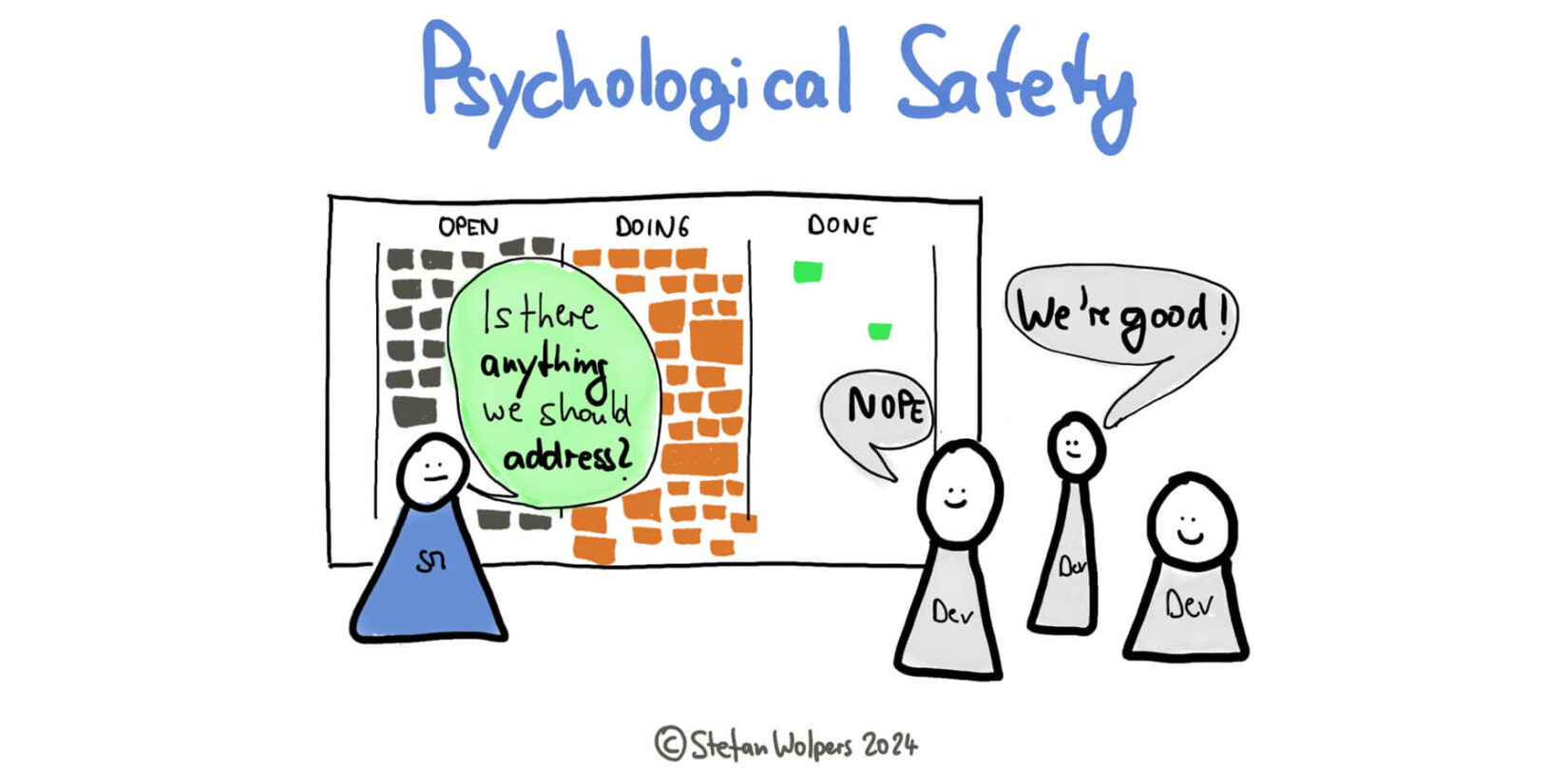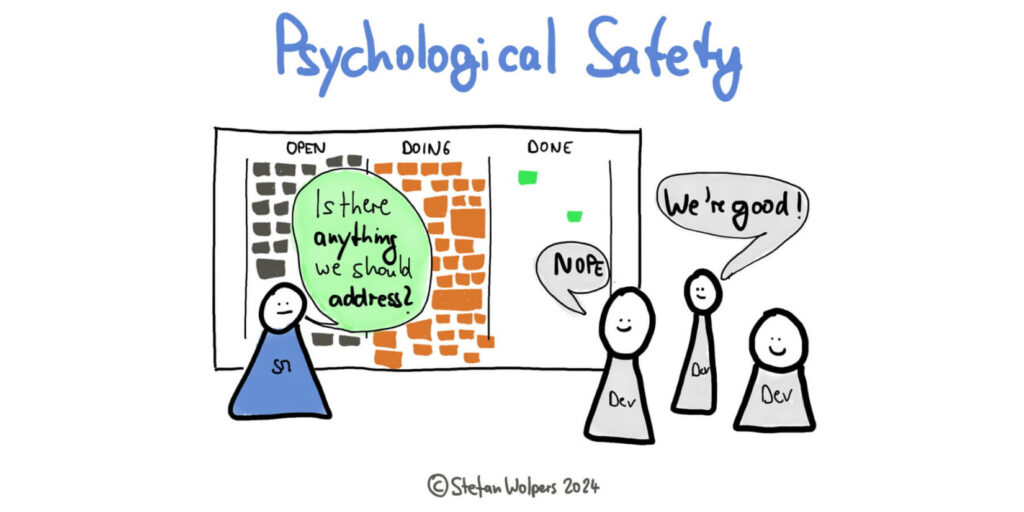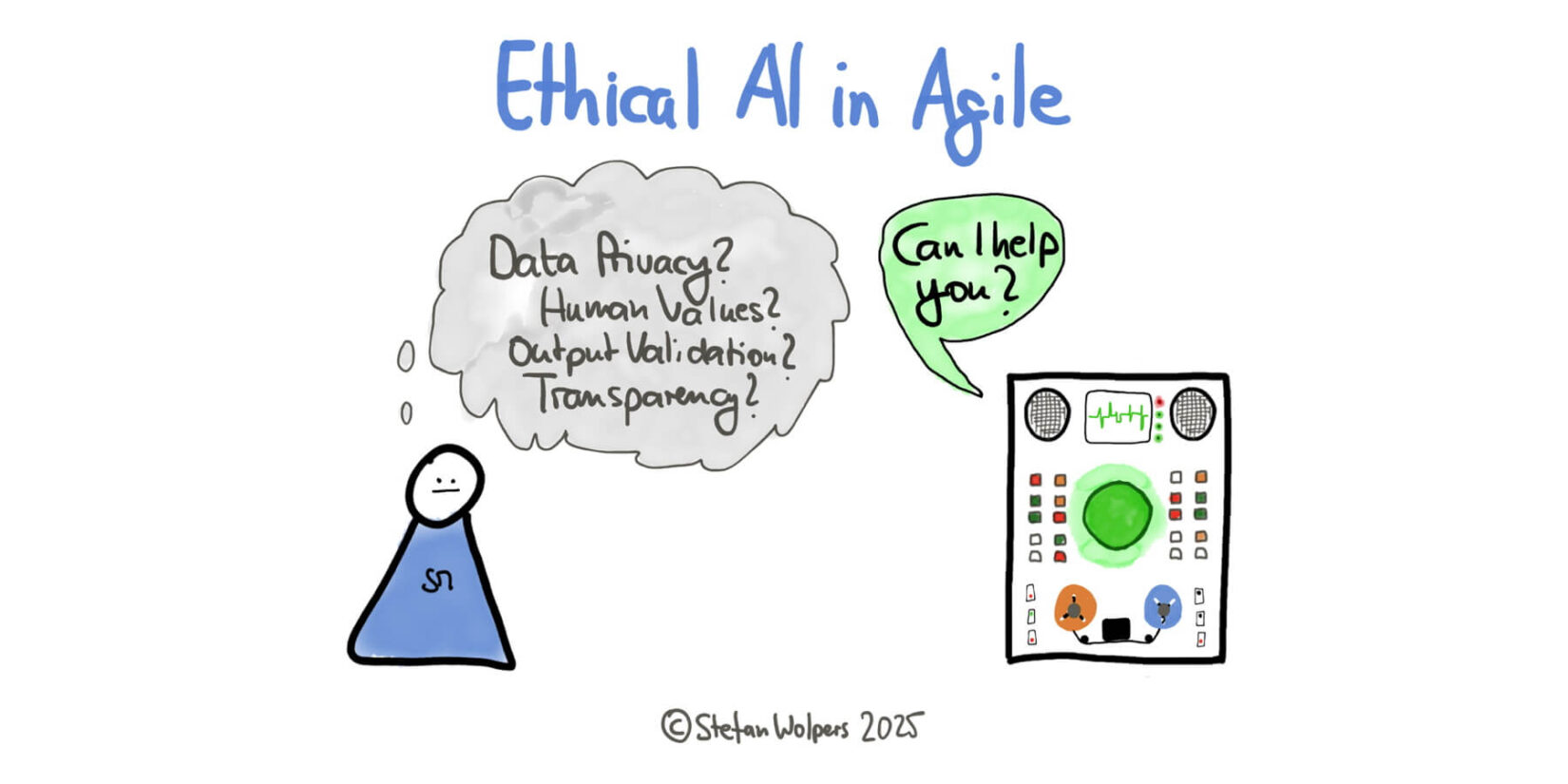TL; DR: Psychological Safety as a Competitive Edge
Psychological safety isn’t about fluffy “niceness”—it is the foundation of agile teams that innovate, adapt, and deliver.
When teams fearlessly debate ideas, admit mistakes, challenge norms, and find ways to make progress, they can outperform most competitors. Yet, many organizations knowingly or unknowingly sabotage psychological safety—a short-sighted and dangerous attitude in a time when knowledge is no longer the moat it used to be. Read on to learn how to keep your competitive edge.

🗳️ AI for Careers: Should Stefan Build a Course?
🇩🇪 Zur deutschsprachigen Version des Artikels: Psychologische Sicherheit: Missverstanden, dennoch von entscheidender Bedeutung.
🗞 Shall I notify you about articles like this one? Awesome! You can sign up here for the ‘Food for Agile Thought’ newsletter and join 42,000-plus subscribers.
The Misinterpretation of Psychological Safety
I’ve noticed a troubling trend: While “psychological safety” is increasingly embraced as an idea, it is widely misunderstood. Too often, it is conflated with comfort, an always-pleasant environment where hard conversations are avoided and consensus is prized over candor. This confusion isn’t just conceptually muddy; it actively undermines the very benefits that psychological safety is meant to enable.
So, let’s set the record straight. Actual psychological safety is not about putting artificial harmony over healthy conflict. It is not a “feel-good” abstraction or a license for unfiltered venting. At its core, psychological safety means creating an environment of mutual trust and respect that enables candid communication, calculated risk-taking, and the open sharing of ideas – even and especially when those ideas challenge the status quo. (There is a reason why three out of five Scrum Values—openness, respect, and courage—foster an environment where psychological safety flourishes.)
When Amy Edmondson of Harvard first introduced the term, she defined it as a “shared belief held by members of a team that the team is safe for interpersonal risk-taking.” [Source.] Digging deeper, she clarified that psychological safety is about giving candid feedback, openly admitting mistakes, and learning from each other.
Note the key elements here: candor, risk-taking, and learning. Psychological safety doesn’t mean we shy away from hard truths or sweep tensions under the rug. Instead, it gives us the relational foundation to surface those tensions and transform them into growth. It is the baseline of trust that allows us to be vulnerable with each other and do our best work together.
When teams misunderstand psychological safety, they tend to fall into one of two dysfunctional patterns:
- Artificial harmony: Conflict is avoided at all costs. Dissenting opinions are softened or withheld to maintain an illusion of agreement. On the surface, things seem rosy – but underneath, resentments fester, mediocre ideas slip through unchecked, and the elephants in the room live happily ever after.
- False bravado: The team mistakes psychological safety as an excuse for unfiltered “brutal honesty.” Extroverts voice critiques without care for their impact, bullying the introverts, thus eroding the trust and mutual respect that proper psychological safety depends on.
Both failure modes arise from the same fundamental misunderstanding: psychological safety prioritizes comfort over candor or honesty over care. In reality, true psychological safety dismisses these false dilemmas. It involves discovering how to engage in direct, even challenging conversations in a way that enhances rather than undermines relationships and trust.
Cannot see the form? Please click here.
Psychological Safety and Radical Candor
This is where the concept of “radical candor” comes in. Coined by Kim Scott, radical candor means giving frank, actionable feedback while showing that you care about the person on the receiving end. It is a way of marrying honesty and empathy, recognizing that truly constructive truthtelling requires a bedrock of interpersonal trust. [Source.]
This combination of directness and care is at the heart of psychological safety, and it is utterly essential for agile teams. Agile’s promise of responsiveness to change, creative problem-solving, and harnessing collective intelligence depends on team members’ willingness to speak up, take smart risks, and challenge established ways of thinking. This requires an environment where people feel safe not just supporting each other but productively sparring.
Consider the Daily Scrum or stand-up, a hallmark Agile event. The whole point is for team members to surface obstacles, ask for help, and realign around shifting goals. But that is hard to do if people feel pressured to “seem fine” or avoid rocking the boat. Actual psychological safety creates space for people to say, “I’m stuck and need help,” “I don’t know,” or “I disagree with that approach” without fear of judgment or retribution.
Or take the Retrospective, which is also dedicated to surfacing and learning from failure. (Of course, we also learn from successes.) If people think that talking openly about mistakes will be held against them, they’ll naturally ignore, massage, or sanitize what happened. (This is also the main reason a team should not include members with a reporting hierarchy between them.) Psychological safety shifts that calculus. It says, “We’re in this together, win or lose,” which paradoxically gives teams the courage to scrutinize their losses more rigorously to learn from failure.
Zoom out, and you’ll see psychological safety running like a golden thread through all the core Agile principles: “individuals and interactions over processes and tools,” “customer collaboration over contract negotiation,” and “responding to change over following a plan.” Enacting these values in the wild requires team environments of enormous interpersonal trust and openness. That is the singular work of psychological safety—and it is not about being “soft” or avoiding hard things—quite the opposite. (Think Scrum Values; see above.)
The research shows that psychological safety isn’t just a kumbaya aspiration – it is a performance multiplier. Google’s comprehensive Project Aristotle, which studied hundreds of teams, found that psychological safety was the single most significant predictor of team effectiveness. Teams with high psychological safety consistently delivered superior results, learned faster, and navigated change more nimbly. They also tended to have more fun in the process. [Source.]
Moreover, teams with high psychological safety are more likely to create value for customers, contribute to the bottom line, retain top talent, and generate breakthrough innovations—the ultimate competitive advantage. In other words, psychological safety isn’t a nice-to-have; it is a strategic necessity and a profitable asset.
So how do we cultivate authentic psychological safety on our teams? A few key practices:
- Frame the work as learning: Position every project as an experiment and every failure as vital data. Publicly celebrate smart risks, regardless of outcome. Make it explicit that missteps aren’t just tolerated—they’re eagerly mined for gold.
- Model fallibility: As a leader, openly acknowledge your own mistakes and growth edges. Share stories of times you messed up and what you learned. Demonstrating vulnerability is a powerful signal that it is safe for others to let their guards down, too. (Failure nights are a great way of spreading this message.)
- Ritualize reflection: Take Retrospectives seriously to candidly reflect on what’s working and what’s not. Using structured prompts and protocols helps equalize airtime so all voices are heard. (Think, for example, of Liberating Structures’ Conversation Café.) The more habitual reflection becomes, the more psychological safety will deepen. If necessary, consider employing anonymous surveys to give everyone a voice.
- Teach tactful candor: Train the team in frameworks for giving constructive feedback, such as the SBI (situation-behavior-impact) model or non-violent communication. Emphasize that delivering hard truths with clarity and care is the ultimate sign of respect—for the individual and the shared work.
- Make space for being a mensch: Kickoff meetings with quick personal check-ins. Encourage people to bring their whole messy, wonderful selves to work. Share gratitude, crack jokes, and celebrate the small wins. Psychological safety isn’t sterile; it is liberatingly human.
Most importantly, recognize that building and sustaining psychological safety is an ongoing practice—not a one-and-done box to check. It requires a daily recommitment to choosing courage over comfort, purpose over posturing, and the hard and necessary truths over the easy fake-outs.
Like any meaningful discipline, it is not always comfortable. Working and relating in a psychologically safe way can sometimes feel bumpy and exposing. We may give clumsy feedback, stumble into miscommunications and hurt feelings, and face hard facts we’d rather avoid.
But that is the point: genuine psychological safety transforms uncomfortable moments from threats into opportunities. It allows us to keep showing up and learning together, especially when we feel most vulnerable. It fosters a team culture that is resilient enough to endure the necessary friction of honest collaboration and turns them into something impactful and clarifying.
That is the promise of psychological safety. More than just another buzzword or checklist item, it is about cultivating the soil for enduringly healthy and productive human relationships at work. It is about creating the conditions that support us in growing into them together. Put simply, without psychological safety, Agile can’t deliver on its potential. With psychological safety, Agile can indeed come alive as a force for creativity, innovation, and, yes, joy at work.
Conclusion
Start by looking honestly at your team: How safe do people feel taking risks and telling hard truths? What is the one conversation, the one elephant in the room, you have been avoiding that might unlock the next level of performance and trust? Challenge yourself to initiate that talk next week—and watch the ripple effects unfold.
Embracing this authentic version of psychological safety won’t be a walk in the park. You and your team will face uncomfortable moments of friction and vulnerability. Team members may drop out, feeling too stressed about it. But, leaning into that discomfort is precisely how you will unleash your true potential. Psychological safety is about building a resilient team to navigate tough challenges and have difficult conversations because you know you have each other’s backs. That foundation will allow you to embrace agility as it is meant to be.
Related Content
Scrum Master Skills: Visualizing the Cost of Team Building with the Tuckman Model.
Antecedents of psychological safety in agile software development teams.
How Safe So You Feel? A Self-Assessment Survey on Psychological Safety in the Team.
👆 Stefan Wolpers: The Scrum Anti-Patterns Guide (Amazon advertisement.)
📅 Scrum Training Classes, Workshops, and Events
Learn more about the Lean Tech Manifesto with our Scrum training classes, workshops, and events. You can secure your seat directly by following the corresponding link in the table below:
See all upcoming classes here.
You can book your seat for the training directly by following the corresponding links to the ticket shop. If the procurement process of your organization requires a different purchasing process, please contact Berlin Product People GmbH directly.
✋ Do Not Miss Out and Learn more about Psychological Safety — Join the 20,000-plus Strong ‘Hands-on Agile’ Slack Community
I invite you to join the “Hands-on Agile” Slack Community and enjoy the benefits of a fast-growing, vibrant community of agile practitioners from around the world.
If you would like to join all you have to do now is provide your credentials via this Google form, and I will sign you up. By the way, it’s free.
Prepare yourself for Psychological Safety by studying the free Scrum Anti-Patterns Guide:
The post Psychological Safety: Misunderstood, Yet Mission-Critical appeared first on Age-of-Product.com.










